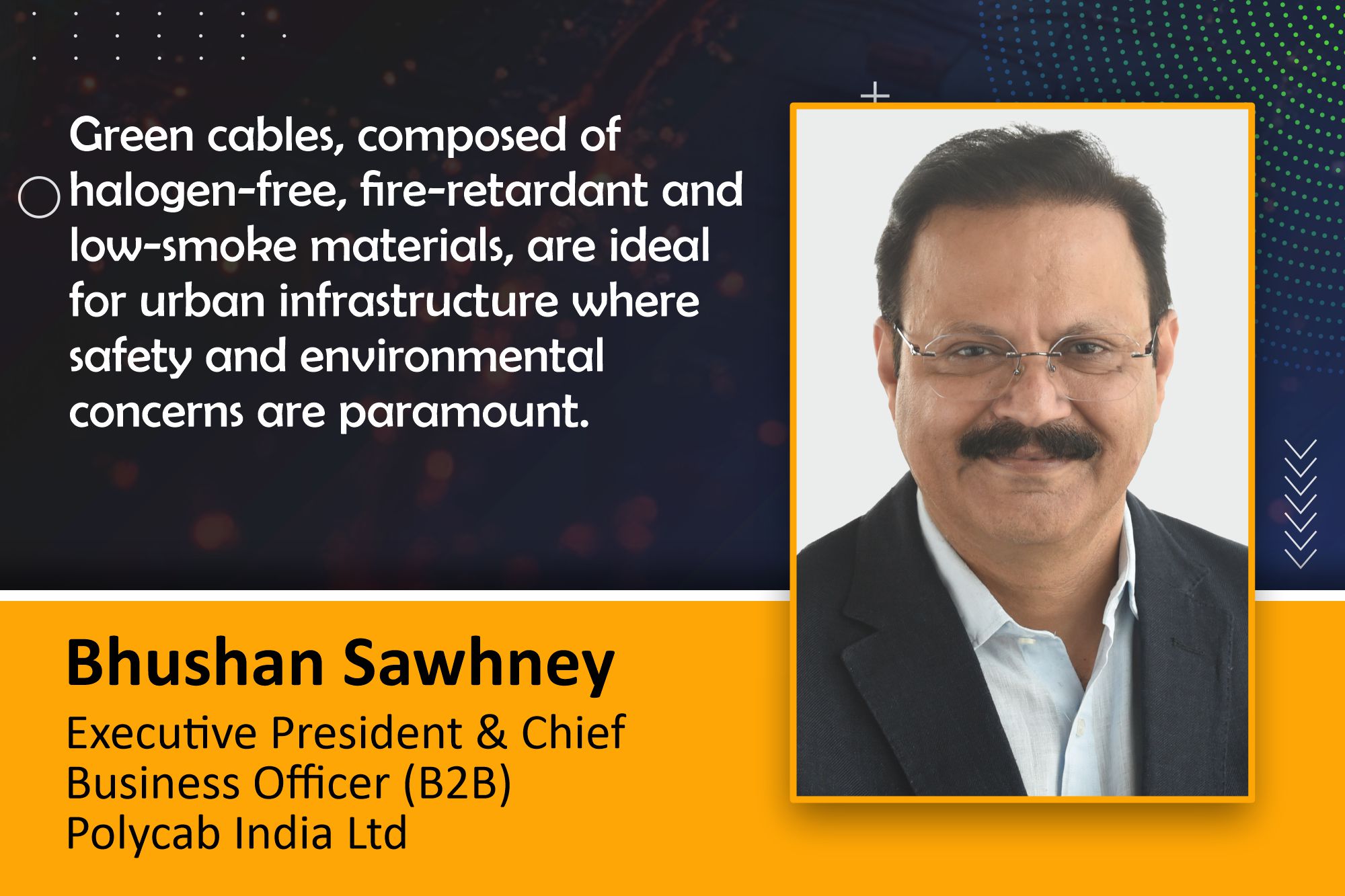Cross-linked polyethylene (XLPE) cables minimising energy loss
By EPR Magazine Editorial January 27, 2025 8:09 pm IST
By EPR Magazine Editorial January 27, 2025 8:09 pm IST

The electrical industry is evolving rapidly, prioritising energy efficiency and sustainability through advanced cable technologies. Green cables, utilising eco-friendly materials, enhance safety and minimise environmental impact, while smart cables integrate sensors for real-time monitoring and optimised power distribution. This shift aligns with global sustainability goals, such as India’s 2030 target of 500 GW of non-fossil fuel capacity. Companies like Polycab actively contribute to this transition by investing in high-efficiency XLPE cables and integrating IoT capabilities for enhanced energy management and predictive maintenance. This focus on innovation is driven by increasing demand for sustainable energy solutions and robust infrastructure development. Bhushan Sawhney from Polycab India shares his insights on these developments with EPR.
How do green and smart cables improve energy efficiency and align with sustainability goals?
The electrical industry increasingly prioritises energy efficiency and loss reduction through green and smart cables. These advanced cables utilise materials and technologies that minimise resistance and transmission losses. Green cables, composed of halogen-free, fire-retardant and low-smoke materials, are ideal for urban infrastructure where safety and environmental concerns are paramount.
Smart cables further enhance functionality by integrating sensors and real-time monitoring, which is crucial for smart grids. These features enable dynamic load management, predictive maintenance, and optimised power distribution, improving grid reliability and reducing operational costs. This transition aligns with global and local sustainability goals, such as the 2030 target of 500 GW of non-fossil fuel capacity.
We actively participate in this shift by investing in green and smart solutions. Our portfolio includes high-efficiency, cross-linked polyethylene (XLPE) cables designed to minimise energy loss, contributing to a more sustainable and efficient electrical infrastructure.
How is Polycab enhancing cable performance, sustainability and IoT capabilities for energy management?
The convergence of smart grids and IoT drives the development of sophisticated, specialised, and adaptable cable and wiring solutions. This integration pushes the wires and cables industry toward enhanced performance, efficiency, sustainability and security, stimulating material and power distribution innovation.
Polycab utilises advanced materials science to create eco-friendly, lightweight, and thermally resistant cables with superior durability. These cables ensure reliable performance in demanding environments and minimise environmental impact. IoT integration enhances their capabilities, enabling real-time energy management and predictive maintenance.Whether supporting renewable energy sources, powering smart homes, or enabling industrial automation, our cables are active participants in the energy ecosystem, not merely conductors. By combining material innovation with IoT, we are leaders in providing future-ready solutions for sustainable energy management.
What factors drive growth in the Indian wires and cables market?
The Indian wires and cables market is experiencing significant growth driven by government initiatives, rapid urbanisation and a strong push towards renewable energy. Government programmes like the National Infrastructure Pipeline (NIP) and Pradhan Mantri Awas Yojana (PMAY) are fuelling substantial investments in transportation, housing, and energy infrastructure, particularly in Tier II and Tier III cities. This investment boosts cable demand across residential, commercial, and large-scale infrastructure projects. The real estate sector, projected to reach $1 trillion by 2030 due to these programmes and increasing middle-class spending, further amplifies the need for electrical products. The commitment to net-zero emissions by 2070 drives massive investment in renewable energy, targeting 500 GW of capacity, including approximately 270 GW from solar. This has transformed the solar wire and cable segment, creating a high demand for specialised cables for long-distance transmission and complex grid connections. This growth is further supported by decreasing solar panel costs, rising energy demand, and increased environmental awareness.
Within this dynamic market, organised players like Polycab, holding 70 per cent of the market share, are well-positioned for growth. We began manufacturing Solar DC cables in 2012, expanding our portfolio to include solar on-grid inverters, solar DC MCBs, and Solar PV modules. And aims to be a comprehensive provider for major solar projects. This reflects a broader market trend towards prioritising quality and safety standards favouring these established companies. Finally, investments in power generation, transmission, and distribution networks are accelerating demand for power and control cables. The ongoing digitalisation and broadband expansion fuel demand for telecom cables, especially optic fibre. This combination of public and private sector efforts, focused on renewable energy and robust infrastructure development, ensures continued expansion for the Indian wires and cables market across diverse applications.
We use cookies to personalize your experience. By continuing to visit this website you agree to our Terms & Conditions, Privacy Policy and Cookie Policy.